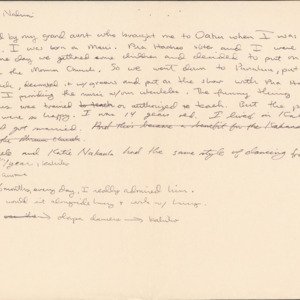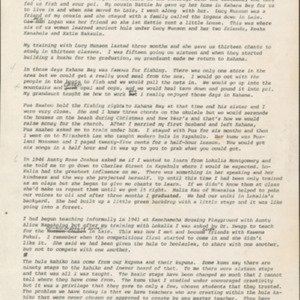Sally Moanike‘alaonāpua and Makahikina Wood Nālua‘i
Title
Sally Moanike‘alaonāpua and Makahikina Wood Nālua‘i
Description
Sally Moanike‘alaonāpuamakahikrna Wood Nālua‘i
Sally Wood Naluaʻi graduated from the same hula class of Lokalia Montgomery that produced Māʻiki Aiu Lake and Lani Kalama.
When I returned from Monterey in 1960 I really had forgotten everything. I was told I would lose my talent if I didn’t continue to study and it was gone. When I came home I hugged my drum and ipu, and I said a little prayer and began to pah. And nothing came to me. I drummed and drummed, and then I started to hum along and as I continued I began to remember “Kaulīlua”.
I was born on the island of Maui in the little town of Paia. I was brought up by my granduncle and grandaunt whose name was Kekuo‘okalani. We left Maui when I was eleven and in those days there were no planes but they had ships. The only ship I remember was the Claudine. This was an inter-island ship. We didn’t have money to pay for rooms so we stayed downstairs in the steerage with the selamoku and they fed us fish and sour poi. My cousin Hattie Au gave up her home in Kahana Bay for us to live in and when she moved to Lā‘ie, I went along with her. Lucy Munson was a friend of my cousin and she stayed with a family called the Logans down in Lā‘ie. Mr. Logan was her friend so she let Hattie rent a little house. This was where six of us women learned ancient hula under Lucy Munson and her two friends, Keaka Kanahele and Katie Nākaula.
My training with Lucy Munson lasted three months and she gave us thirteen chants to study in thirteen classes. I was fifteen going on sixteen and when they started building a kuahu for the graduation, my grandaunt made me return to Kahana.
In those days Kahana Bay was famous for fishing. There was only one store in the area but we could get a really good meal from the sea. I would go out with the people in the boats to fish and we would pull the nets in. We would go up into the mountains and catch ‘ōpae and ‘o‘opu, and we would haul taro down and pound it into poi. My grandaunt taught me how to work and I really enjoyed those days in Kahana.
Pua Ha‘aheo held the fishing rights to Kahana Bay at that time and his sister and I were very close. She and I knew three chords on the ‘ukulele but we would serenade the houses on the beach during Christmas and New Year’s and that’s how we would raise money for the church. After I married my first husband and left Kahana, Pua Ha’aheo asked me to train under him. I stayed with Pua for six months and then I went on to Elizabeth Lau who taught modern hula in Kapahulu. Her kumu was Pualani Mossman and I payed twenty-five cents for a half-hour lesson. You would get six songs in a half hour and it was up to you to grab what you could get.
In 1946 Aunty Rose Joshua asked me if I wanted to learn from Lokalia Montgomery and she told me to go down to Charles Street in Kapahulu where I would be expected. Lokalia had the greatest influence on me. There was something in her speaking and her kindness and the way she projected herself. Up until this time I had been only trained as an ‘ōlapa but she began to give me chants to learn. If we didn’t know them at class she’d make us repeat them until we got it right. Malia Kau of Moanalua helped to paka our voices to oli and after three months I graduated. We had our ‘ūniki in Lokalia’s backyard. She had built up a little green backdrop with a little stage and it was like going into a forest.
I had begun teaching informally in 1941 at Kamehameha Housing Playground with Aunty Alice Namakelua but after my training with Lokalia I was asked by Dr. Swapp to teach for the Church College of Hawai‘i in Lā‘ie. This was how I met and became close friends with Kawena Pūku‘i. I remember when the competitions first started to come in and she didn’t like it. She said we had been given the hula to ho‘olaule‘a to share with one another but not to compete with one another.
The hula kahiko has come from our kupuna and their kupuna. Some kumu say there are ninety steps to the kahiko and I never heard of that. To me there were sixteen steps and that was all I was taught. The basic steps have been changed so much that I cannot tell where they have come from. The kumu that I studied under encouraged creativity but it was a privilege that they gave to only a few, chosen students that they trusted. The problem we have today is that we have teachers who are creating within the hula kahiko that were never chosen or approved to create by any master teacher. They have approved themselves.
Sally Wood Naluaʻi graduated from the same hula class of Lokalia Montgomery that produced Māʻiki Aiu Lake and Lani Kalama.
When I returned from Monterey in 1960 I really had forgotten everything. I was told I would lose my talent if I didn’t continue to study and it was gone. When I came home I hugged my drum and ipu, and I said a little prayer and began to pah. And nothing came to me. I drummed and drummed, and then I started to hum along and as I continued I began to remember “Kaulīlua”.
I was born on the island of Maui in the little town of Paia. I was brought up by my granduncle and grandaunt whose name was Kekuo‘okalani. We left Maui when I was eleven and in those days there were no planes but they had ships. The only ship I remember was the Claudine. This was an inter-island ship. We didn’t have money to pay for rooms so we stayed downstairs in the steerage with the selamoku and they fed us fish and sour poi. My cousin Hattie Au gave up her home in Kahana Bay for us to live in and when she moved to Lā‘ie, I went along with her. Lucy Munson was a friend of my cousin and she stayed with a family called the Logans down in Lā‘ie. Mr. Logan was her friend so she let Hattie rent a little house. This was where six of us women learned ancient hula under Lucy Munson and her two friends, Keaka Kanahele and Katie Nākaula.
My training with Lucy Munson lasted three months and she gave us thirteen chants to study in thirteen classes. I was fifteen going on sixteen and when they started building a kuahu for the graduation, my grandaunt made me return to Kahana.
In those days Kahana Bay was famous for fishing. There was only one store in the area but we could get a really good meal from the sea. I would go out with the people in the boats to fish and we would pull the nets in. We would go up into the mountains and catch ‘ōpae and ‘o‘opu, and we would haul taro down and pound it into poi. My grandaunt taught me how to work and I really enjoyed those days in Kahana.
Pua Ha‘aheo held the fishing rights to Kahana Bay at that time and his sister and I were very close. She and I knew three chords on the ‘ukulele but we would serenade the houses on the beach during Christmas and New Year’s and that’s how we would raise money for the church. After I married my first husband and left Kahana, Pua Ha’aheo asked me to train under him. I stayed with Pua for six months and then I went on to Elizabeth Lau who taught modern hula in Kapahulu. Her kumu was Pualani Mossman and I payed twenty-five cents for a half-hour lesson. You would get six songs in a half hour and it was up to you to grab what you could get.
In 1946 Aunty Rose Joshua asked me if I wanted to learn from Lokalia Montgomery and she told me to go down to Charles Street in Kapahulu where I would be expected. Lokalia had the greatest influence on me. There was something in her speaking and her kindness and the way she projected herself. Up until this time I had been only trained as an ‘ōlapa but she began to give me chants to learn. If we didn’t know them at class she’d make us repeat them until we got it right. Malia Kau of Moanalua helped to paka our voices to oli and after three months I graduated. We had our ‘ūniki in Lokalia’s backyard. She had built up a little green backdrop with a little stage and it was like going into a forest.
I had begun teaching informally in 1941 at Kamehameha Housing Playground with Aunty Alice Namakelua but after my training with Lokalia I was asked by Dr. Swapp to teach for the Church College of Hawai‘i in Lā‘ie. This was how I met and became close friends with Kawena Pūku‘i. I remember when the competitions first started to come in and she didn’t like it. She said we had been given the hula to ho‘olaule‘a to share with one another but not to compete with one another.
The hula kahiko has come from our kupuna and their kupuna. Some kumu say there are ninety steps to the kahiko and I never heard of that. To me there were sixteen steps and that was all I was taught. The basic steps have been changed so much that I cannot tell where they have come from. The kumu that I studied under encouraged creativity but it was a privilege that they gave to only a few, chosen students that they trusted. The problem we have today is that we have teachers who are creating within the hula kahiko that were never chosen or approved to create by any master teacher. They have approved themselves.
Citation
“Sally Moanike‘alaonāpua and Makahikina Wood Nālua‘i,” Nā Kumu Hula Archive, accessed November 28, 2025, https://nakumuhula.org/archive/items/show/73.





